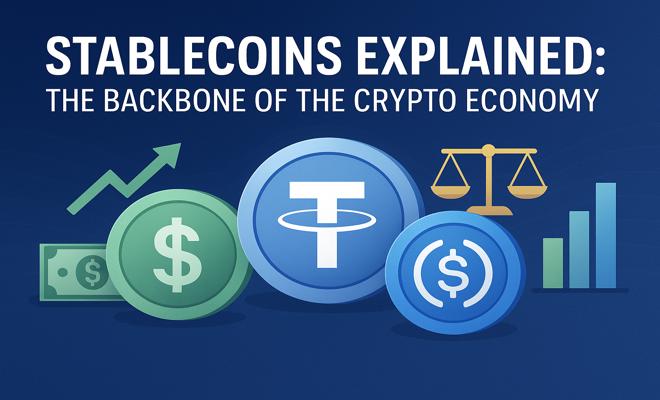
Stablecoins Explained: The Backbone of the Crypto Economy 💵⚖️
In the fast-changing world of cryptocurrencies, price swings are very common. But stablecoins are an exception. They combine the advantages of blockchain technology with the steadiness of regular money like the US Dollar or Euro. But what exactly are stablecoins? And why have they become so important for the crypto economy worldwide? Let’s explore!
🔍 Understanding Stablecoins
A stablecoin is a special kind of cryptocurrency designed to keep its value steady. Most stablecoins are linked, or "pegged," to real-world assets like traditional currencies (for example, the US Dollar), or sometimes to commodities like gold. Unlike Bitcoin or Ethereum, which can jump or drop in value a lot, stablecoins stay more stable. This makes them very useful as money you can spend or save in the crypto world.
📚 Different Types of Stablecoins
Stablecoins come in several types, based on how they keep their value steady:
1. Fiat-Collateralized Stablecoins 🏦
- These stablecoins are backed by actual money held in a bank. For every stablecoin created, there is an equal amount of real money stored somewhere safe.
- Examples: Tether (USDT), USD Coin (USDC), TrueUSD (TUSD)
- Pros: Very stable and trusted because they have real money behind them.
- Cons: You must trust the company holding the money since they control the reserves.
2. Crypto-Collateralized Stablecoins 🧮
- These are backed by other cryptocurrencies. Usually, they keep more crypto locked up than the stablecoins they issue, to protect against price drops.
- Example: DAI (backed by Ethereum and other cryptos)
- Pros: Decentralized and transparent because they use smart contracts instead of a single company.
- Cons: The system can be complicated and relies heavily on technology working well.
3. Algorithmic Stablecoins 🤖
- These don’t hold any real money or crypto as backup. Instead, they use computer programs (algorithms) to adjust how many coins exist, keeping the price stable.
- Examples: Frax (FRAX), Ampleforth (AMPL)
- Pros: Fully decentralized and innovative.
- Cons: Can be risky and sometimes fail during sudden market changes.
🌐 How Are Stablecoins Used?
Stablecoins have changed many things in crypto. Here are the most common ways people use them:
- 🔁 Trading: Used as a safe and steady currency to buy and sell other cryptocurrencies.
- 🌍 Remittances: Sending money across borders quickly and cheaply.
- 💰 DeFi Services: Borrowing, lending, and earning interest on crypto platforms.
- 🛒 Payments: Accepted by some online shops and services.
- 📉 Hedging: Holding stablecoins to avoid losses when other cryptocurrencies drop in price.
🧠 Benefits of Using Stablecoins
- ✅ Price Stability: Less risk of sudden value changes.
- ⚡ Fast Transfers: Instant payments without bank delays.
- 🌍 Global Access: Anyone with internet can use them — no bank account needed.
- 💵 Liquidity: Easy to convert to other currencies or crypto.
- 💡 Smart Contract Friendly: Can be programmed for advanced financial uses.
⚠️ Risks and Challenges
- 🔒 Centralization Concerns: Fiat-backed stablecoins depend on trust in a central company.
- 📜 Regulatory Pressure: Governments are creating new rules that could affect stablecoins.
- 💣 Algorithmic Failures: Some algorithmic stablecoins have lost their peg and value suddenly (like TerraUSD).
- 🤐 Lack of Transparency: Not all stablecoin issuers publish regular audits.
⚖️ Stablecoins and Government Regulation
Authorities worldwide are paying close attention to stablecoins to make sure they are safe and don’t cause financial problems.
- 🇺🇸 USA: Lawmakers are discussing rules to regulate stablecoin issuers, treating some like banks.
- 🇪🇺 EU: The MiCA regulation will set rules for stablecoins and other digital assets.
- 🇸🇬 Singapore: Has created a sandbox to test stablecoin projects under supervision.
🏛️ Stablecoins vs Central Bank Digital Currencies (CBDCs)
People often compare stablecoins with CBDCs. Both bring traditional money to the blockchain but differ in important ways:
- 👨💼 Issuer: CBDCs are created by governments, stablecoins by private companies.
- 🔐 Privacy: Stablecoins usually offer more user anonymity.
- 🧱 Innovation: Stablecoins work well with decentralized finance (DeFi) and other blockchain apps.
🚀 What’s Next for Stablecoins?
Stablecoins will keep being a key part of crypto’s future. We can expect:
- 📈 More companies and institutions using stablecoins for business and payments.
- 🏦 Integration with popular financial apps and services.
- ⚖️ Working together with CBDCs in new hybrid financial systems.
🧭 Final Thoughts
Stablecoins create an important connection between traditional money and the new world of cryptocurrencies. They bring the trust and stability of regular currency with the speed, flexibility, and innovation of blockchain technology. As more people start using cryptocurrencies, understanding stablecoins will be vital for both everyday users and investors.
Stay updated with BitMedia24 for more insightful guides and news about the crypto world. 🌐